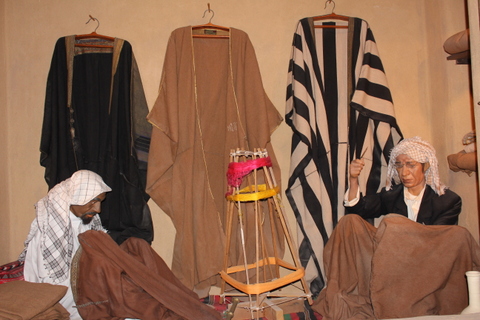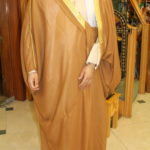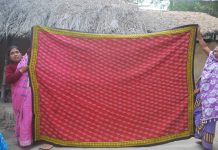Bisht (man’s cloak) making is considered as one of the most important living handicrafts. The traditional form is in high demand by a broad cross-section of the population, including wealthy, middle class, and low income Kuwaitis, as well people for the Arabian Gulf countries. Bishts are either made of wool or camel hair. Wool can be sheared from sheep and lately from lamas. Bishts differ in their thicknesses of the weave, depending on the different seasons of winter, spring, and summer. Winter Bishts are heavy in weight and coarse to touch, however, summer Bishts are lighter in weight and softer to touch.
To make one Bisht, one Bisht weaver (Hayek) and one to four Bisht tailors (Mokhayet) work together depending on the type and quality of the Bisht. In the past, Bisht weavers take one to four days; she work in a specially designed pit floor hand loom to weave enough fabric for one Bisht. After, it would take 7-10 days to tailor it. Wool and camel hair yarns are spun locally and some are imported from Iran, Iraq, and other countries. Originally, natural dyes were used on white wool to give it the desired color. Currently, chemical dyes are used for improved quality of dyeing.
The first Bisht tailor (Mokhayet) sews the Bisht fabric, while the other three tailors work in decorating the shoulders, arms, and chest edges. Each Bisht tailor is specialized in one type of the Bisht decoration. Colored silk Breesam threads are used to decorate the less expensive Bisht. The more expensive Bishts are decorated with metal threads (Zari) made of gold, silver, gold-plated, or silver-plated threads imported from France, Germany, and Japan.
Bisht prices range from about $US 100 to several thousand dollars. Famous Kuwaiti families that had artisans known to be heavily involved in Bisht weaving are Al-Durai, Al-Bahrani, and Al-Sultan. Families that were known for tailoring Bishts include Albaghli, Al-Ameer, Alnajadah, Al-Najdee, Al-Shawaf, Al-Failee, Al-Naser and Al-Attar. Families that were known are Albaghli, Abu Hamad, Al-Hazeem, Alnajadah, Abu-Khamseen, Al-Diwesan, Al-Ateyah, Al-Suliman , Al-Naser and Al-Khawajah.
- Albaghli, Reyad M. (2012). Bisht Albaghli: The History & The Tradition. Albaghli Textile Company, Kuwait.
- Jamal, Mohamad A. (2009). The Old Crafts, Trades, and Commercial Activities in Kuwait. Center for Research and Studies on Kuwait. Kuwait.
002-1) Two Bisht makers sewing two winter Bishts. On the wall there are three different Bishts: a Black summer Bisht woven from fine wool, A brown winter Bisht woven from camel hair, and stripped black and white winter Bisht (Al-Bisht Al-Barqah) woven from wool. Picture was taken from the Popular Traditional Museum in Kuwait National Museum.
002-2) Gelded metal threads “Gelded Zari” tassels to be used on both front sides of the Bisht at the chest hight.
002-3) The front side of a spring Bisht 002-3) The rare side of a spring Bisht woven out of fine wool. woven out of fine wool.







Excellent work